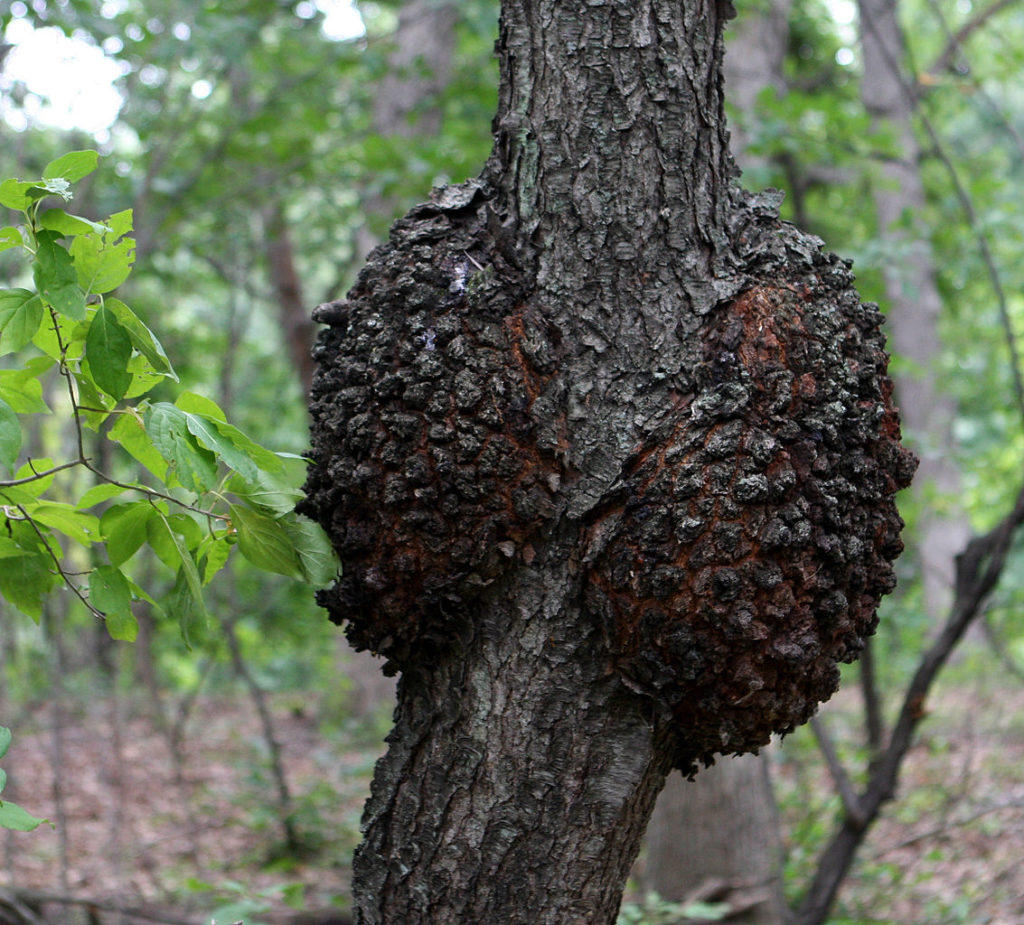Black knot (Apiosporina morbosa) is a fungal disease that infects over 25 species of Prunus. It is caused by the fungus Apiosporina morbosa. Outbreaks of black knot may occur in landscape and forested settings. The knots that form on infected plants can cause extensive defoliation, and foliar dieback. Tree mortality is common in young or highly susceptible species of Prunus.
Distribution & Habitat
Black knot occurs across North America, wherever susceptible trees are present.
Hosts
Black knot primarily affects plum and cherry trees. Over 25 species of Prunus are susceptible to infection, including American, Canadian, European, Japanese, and purple-leaf plum, as well as chokeberry, and European bird cherry. Infections also occur on amur, apricot, chokecherry, and flowering almond, as well as several other varieties of cherry, including Nanking, pin, Sargent, sour, and western sand cherry.
Disease Cycle
The fungus overwinters in the galls on infected plants. During wet periods in spring, ascospores are expelled by fruiting structures that have formed on the galls, and disseminated by air currents or splashes of rain to nearby plants, which they readily infect. Succulent green shoots and wounded tissues are most susceptible to infection by ascospores. The ascospores may continue to be discharged until two to three weeks after the blooming period has ceased. The spores germinate within the susceptible tissue. Once the fungus has become established, it begins to expand within the plant, releasing chemicals that stimulate cellular growth.
The enlargement of the cellular tissues results in the formation of swollen black galls, or knots, on the branches and twigs of infected plants. During the first year, the knots develop slowly. They gradually increase in size, appearing as small galls by the end of the growing season. The knots become inactive during winter. They resume development the following spring, enlarging considerably. During the second year, the knots harden, and form black fruiting structures called conidia that extend over their surfaces. The knots continue to grow until winter, when they once again cease activity.
The following spring, the knots break dormancy, and begin to produce velvety green ascospores, infectious spores that are contained within the fruiting structures. Once conditions have become sufficiently moist, the fruiting structures rupture, and release the ascospores, which are dispersed by air currents or splashes of rain to susceptible plants, where they initiate new infections.
The knots are composed of plant and fungal tissue. Initially, they are soft in texture, with a greenish-brown shade. The knots vary in size, measuring between 1 and 30 cm in diameter. As the knots thicken, they may encircle and girdle the infected branches. Girdled branches often die back. Knots will continue to grow each year until a branch has been girdled. If a branch persists, the knots become perennial, producing new spores every spring.
Symptoms of Infection
Knobby, irregular black swellings will grow parallel along the length of infected stems and branches. During the first year, the knots may be difficult to discern. As the galls increase in size, they become more conspicuous. They are most apparent in winter, when the hosts have shed their leaves. Once the galls mature, they harden and turn black. Infected branches may become malformed, assuming a bent or distorted appearance. Girdled branches are often bereft of healthy growth. Leaves that do emerge tend to be stunted, and will generally wilt before expiring in early summer. The canopies of infected plants may become laden with up to several hundred knots. The knots may ooze a sticky liquid, when can be observed streaming down the main trunk of the plant. Older knots may brighten in color, turning white or pink. This discoloration is caused by another fungal parasite, Trichothecium roseum.
Management
- Landscape and forested sites that contain an abundance of Prunus species should be monitored consistently for infection symptoms.
- Prune and dispose of any knots that are present to reduce the incidence of infection. In late winter, remove all branches with swellings, cracks in the bark, or black knots. Diseased plant material should be disposed of thereafter.
- Knots that are cracked or oozing, especially those located on the main trunk of a plant, should be inspected by a certified arborist. Knots that have grown on or into the main trunk can disrupt the structural integrity of the plant, rendering it prone to failure.
- When planting, select trees that exhibit an increased resistance to black knot.
- Fungicides may be utilized to protect young or highly susceptible plants from infection. Initial applications should be performed in early spring, as bud expansion begins. Repeat applications at 7 to 14 day intervals until the shoots mature.


